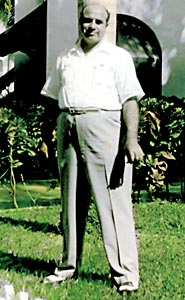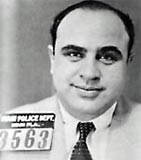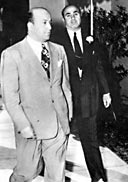
Two years after the hurricane of 1926 and while Miami was still reeling from the collapse of the great Florida land boom, Al Capone quietly purchased a bayfront home on Palm Island through an associate for $40,000, and spent another $100,000 to turn it into a walled-in fortress watchfully guarded by his ever-present security team of seven stalwart Sicilians.
After masterminding a wave of crime ranging from prostitution and bootlegging to a string of alleged murders too numerous to mention, you’d think Al would fit right in to our sordid little metropolis here in Miami, but such was not the case.
You see, even though bootlegging had been a fact of life in Miami since its earliest days, the act of serving up booze to wealthy socialites with a wink and a nod was something altogether different from what Al Capone was bringing to the party, and the last thing Jazz Age Miamians wanted to see in their town was a gang of brutal Chicago street thugs delivering sudden death to anyone standing in the way of their lawless endeavors.
The Miami Daily News and publisher James Cox led the fight against Capone with full-page editorials railing against his arrival. The public’s backlash became so great that at one point Florida Governor Doyle Carlton issued a standing order allowing sheriffs to arrest Capone “on sight.” Of course, that lasted about as long as it took Capone’s lawyers to reach the Dade County courthouse. Time Magazine reported on the heated injunction hearing…
State’s Attorney N. Vernon Hawthorne in Circuit Court sought an order to padlock the Capone estate on the ground that the place was “a public nuisance and a source of annoyance to the community as a harbor for all classes of criminals and desperate characters.” Capone, with his wife, son, lawyers, bodyguards, entered a crowded courtroom to defend himself. Exclaimed Fritz Gordon, Capone attorney: “The whole thing is a political scheme hatched up by State’s Attorney Hawthorne and James Cox, publisher of the Miami Daily News, in a campaign for Hawthorne’s re-election.”
Indicating Capone who looked fat, sleek, self-satisfied, State’s Attorney Hawthorne told the court: “It’s no crime to let a rattlesnake live but if you allow one to roam loose in your backyard where it may bite children, any court in the world will declare it a nuisance and authorize its abatement.” Insisted Capone’s counsel: “No matter how bad Capone may be, he has a perfect right to reside in this community as long as he is law-abiding.” Judge Paul D. Barns took the padlock petition under advisement.
Next Capone heard the Dade County grand jury refer to him as follows: “We endorse, commend and urge all legitimate efforts to exterminate from this community . . . a cancerous growth. The efforts of State’s Attorney Hawthorne toward what is nationally recognized as a menace, a public impostor and an enemy to organized government are of paramount importance. . . . We urge all law-abiding citizens to give their unstinted cooperation to the end that ‘Scarface Al’ Capone, his accomplices and their sinister influences shall not continue to be inflicted upon…Florida.
The government made a valiant effort to boot Scarface out of Florida to be sure, but at the last moment the court derailed the plan…
Judge Ritter thereupon made permanent his injunction protecting Capone from State molestation, [and] gave him some fatherly advice: “Inasmuch as the law’s protecting arm is about you, you should appreciate your citizenship and aid officials in enforcing the law.

Yeah, fat chance, judge. After all, Capone was the guy who used the fact that he was being questioned by the Dade County Solicitor here in Miami on unrelated murder charges as his alibi for the St. Valentine’s Day Massacre.
With the injunction in place, Capone was temporarily free to enjoy his time in Miami, (albeit wearing a bulletproof vest and riding in his seven-ton armored car), and soon spread his tentacles throughout Miami Beach nightlife by gaining ownership interests in nightclubs such as the Palm Island Club, the South Beach Dog Track and the gambling room of the Floridian Hotel on West Avenue.
But, Capone’s problems with the Feds continued to kept his lawyers busy. At one point, upon receiving a subpoena to appear before the Grand Jury in Chicago, Capone’s attorneys submitted an affidavit from his physician stating Capone was suffering from bronchial pneumonia and was confined to bed for ten days, and therefore it would be dangerous to his health to travel to Chicago. In fact, Big Al had spent the bulk of those ten days watching the ponies run at Hialeah.

The law became increasingly unwilling to put up with Capone’s activities and slowly began turning up the heat, as evidenced by an incident in Philadelphia later in 1929 where Capone and one of his bodyguards were arrested for carrying concealed weapons. Within 16 hours they had both been sentenced to a year in jail. Capone was released nine months later for good behavior in March of 1930.
Ultimately, after his conviction on tax evasions charges in 1931 which resulted in an eleven year sentence, Capone was released from prison for the last time in 1939 due to his deteriorating health brought on by late-stage syphilis, and returned to his home on Palm Island to finish out his life.
Shortly before his death from stroke and pneumonia, both his physician and an attending psychiatrist estimated that syphilis had reduced Capone’s mental capacity to that of a 12-year-old child. He spent his final days fishing on Biscayne Bay and issuing phantom orders to a fantasy gang that had long since vanished.
Al Capone died at home on Palm Island in 1947, and with his passing Miamians breathed a collective sigh of relief and bid a less-than-fond farewell to a most unwelcomed visitor.
